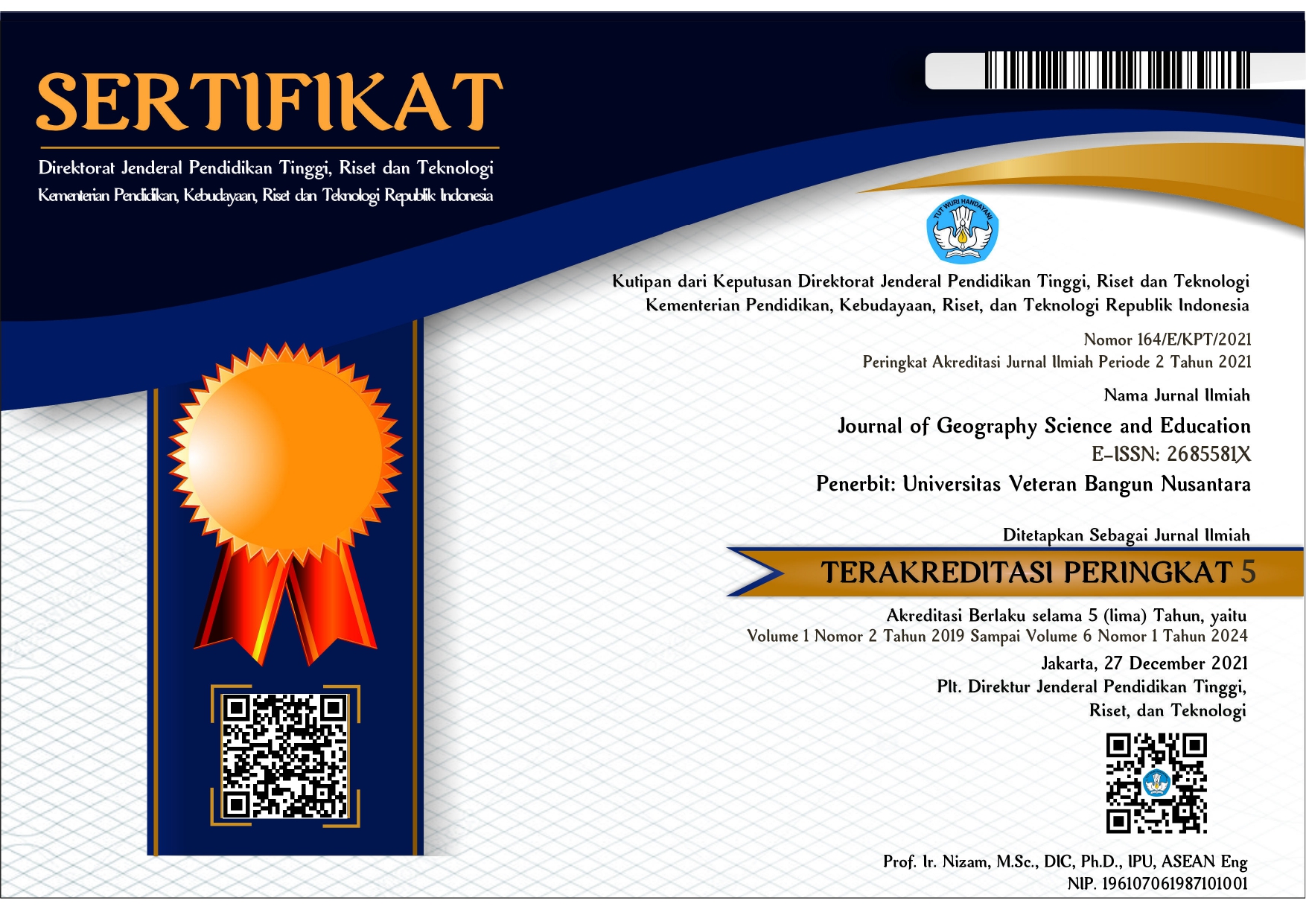THE TOURISM POTENTIAL MAPPING IN WERU SUBDRISTRICT SUKOHARJO REGENCY YEAR 2019
DOI:
https://doi.org/10.32585/jgse.v1i2.465Abstrak
This research aims to: 1) to understand the distribution of tourist location in Weru Sub-district Sukoharjo Regency, 2) to analyse the tourism potential in Weru Subdistrict Sukoharjo Regency. This research used spatial descriptive method by using primary data from coordinate point of each tourist location and secondary data from Indonesian Topographic Map (RBI). The data collection used in this research was documentation and observation, while the data analysing technique was scoring technique and map analysing. Scoring technique is done by using three main variables which are tourism’s attraction, accessibility, facilities and infrastructure. The research result showed that Weru Sub-district has three tourism’s attractions which consist of two cultural attractions and one natural attraction that are spread in two locations in Karanganyar Village (Sirih Temple) and Jatingarang Village (Curug Pleret and Ki Ageng Purwoto Sidiq Tomb). From the observation and the score calculation, it was shown that Curug Pleret was categorized as a very potential tourist site, while Ki Ageng Purwoto Sidiq Tomb and Sirih Temple were categorized as potential and less potential tourist location respectively.
Keywords: Tourist location, tourism potential, Weru Subdistrict
Unduhan
Referensi
Christian, D. (2018). Indonesia Become Top 10 in Global Tourism Rankings 2018. Retrieved March 18, 2019, from https://www.tourism-data.id/indonesia-become-top-10-in-global-tourism-rankings-2018/
Eddy Prahasta.2002. Konsep-konsep Dasar Sistem Informasi Geografis. Bandung : Informatika
Hasan, M. Igbal. 2002. Pokok-pokok Materi Metodologi Penelitian dan Aplikasinya. Jakarta: Ghalia Indonesia.
Partono, B., & Rahman, M. K. (2016). Pemanfaatan Sistem Informasi Geografis (SIG) Untuk Pemetaan Wisata Alam Dan Budaya Sebagai Usaha Perkembangan Kabupaten Sukoharjo. Simposium Nasional RAPI XV. Retrieved March 18, 2019
Undang-undang No. 9 tahun 1990 Tentang Kepariwisataan
Unduhan
Diterbitkan
Cara Mengutip
Terbitan
Bagian
Lisensi
License and Copyright Agreement
In submitting the manuscript to the journal, the authors certify that:
- They are authorized by their co-authors to enter into these arrangements.
- The work described has not been formally published before, except in the form of an abstract or as part of a published lecture, review, thesis, or overlay journal. Please also carefully read JGSE's Posting Your Article Policy at http://pubs2.ascee.org/index.php/ijele/about/editorialPolicies#custom-5
- That it is not under consideration for publication elsewhere,
- That its publication has been approved by all the author(s) and by the responsible authorities – tacitly or explicitly – of the institutes where the work has been carried out.
- They secure the right to reproduce any material that has already been published or copyrighted elsewhere.
- They agree to the following license and copyright agreement.
Copyright
Authors who publish with Journal of Geography Science and Education agree to the following terms:
- Authors retain copyright and grant the journal right of first publication with the work simultaneously licensed under a Creative Commons Attribution License (CC BY-SA 4.0) that allows others to share the work with an acknowledgment of the work's authorship and initial publication in this journal.
- Authors are able to enter into separate, additional contractual arrangements for the non-exclusive distribution of the journal's published version of the work (e.g., post it to an institutional repository or publish it in a book), with an acknowledgment of its initial publication in this journal.
- Authors are permitted and encouraged to post their work online (e.g., in institutional repositories or on their website) prior to and during the submission process, as it can lead to productive exchanges, as well as earlier and greater citation of published work.
Licensing for Data Publication
Journal of Geography Science and Education use a variety of waivers and licenses, that are specifically designed for and appropriate for the treatment of data:
- Open Data Commons Attribution License, http://www.opendatacommons.org/licenses/by/1.0/ (default)
- Creative Commons CC-Zero Waiver, http://creativecommons.org/publicdomain/zero/1.0/
- Open Data Commons Public Domain Dedication and Licence, http://www.opendatacommons.org/licenses/pddl/1-0/
Other data publishing licenses may be allowed as exceptions (subject to approval by the editor on a case-by-case basis) and should be justified with a written statement from the author, which will be published with the article.
Open Data and Software Publishing and Sharing
The journal strives to maximize the replicability of the research published in it. Authors are thus required to share all data, code or protocols underlying the research reported in their articles. Exceptions are permitted but have to be justified in a written public statement accompanying the article.
The associated persistent identifiers (e.g. DOI, or others) of the dataset(s) must be included in the data or software resources section of the article. Reference(s) to datasets and software should also be included in the reference list of the article with DOIs (where available). Where no domain-specific data repository exists, authors should deposit their datasets in a general repository such as ZENODO, Dryad, Dataverse, or others.
Small data may also be published as data files or packages supplementary to a research article, however, the authors should prefer in all cases a deposition in data repositories.






